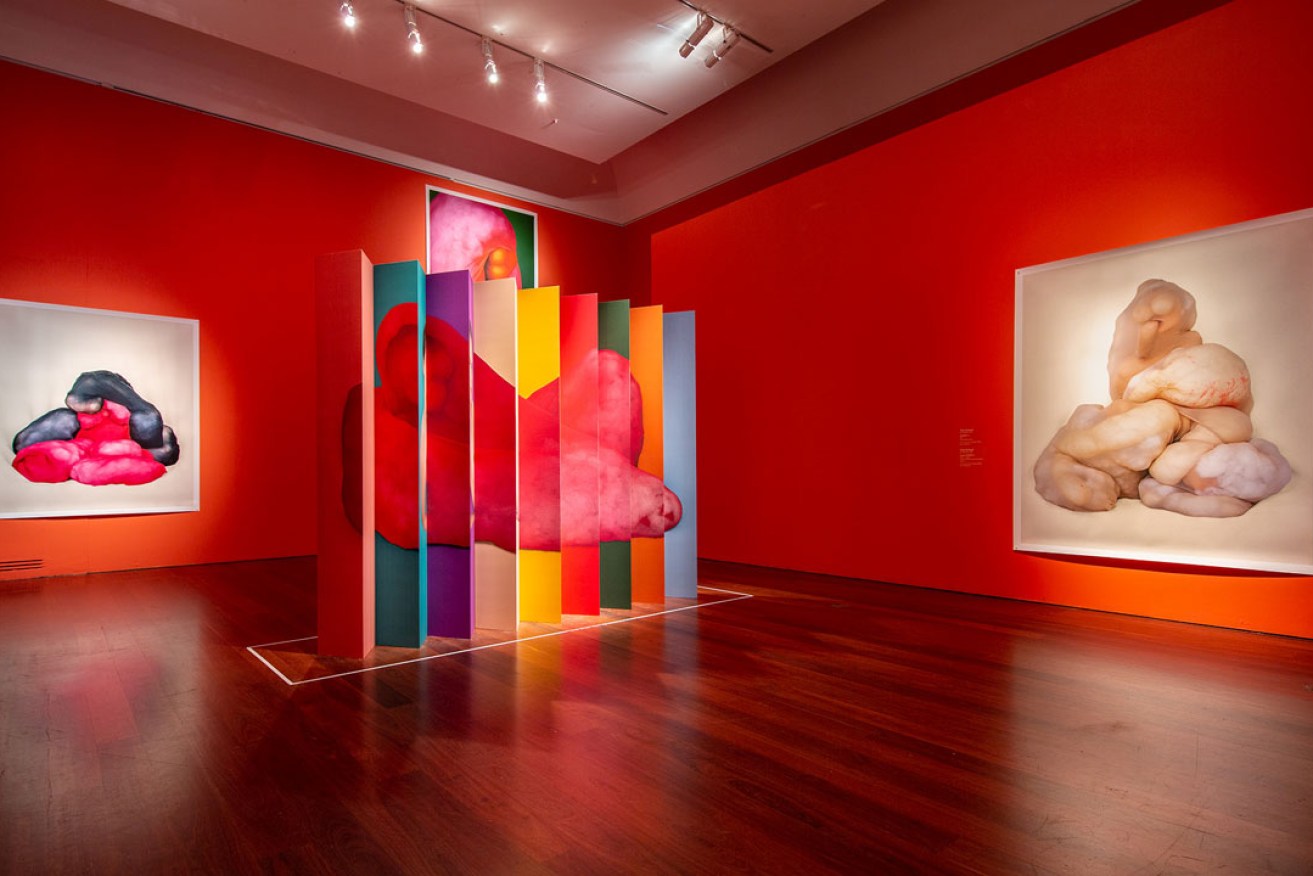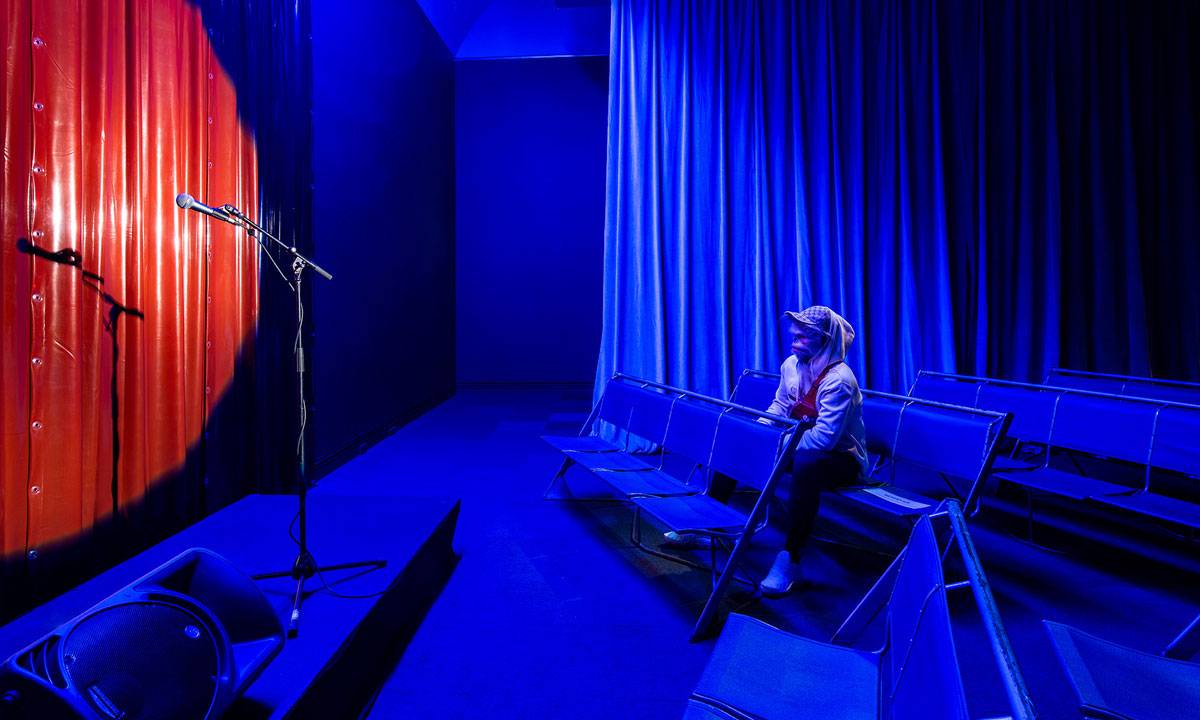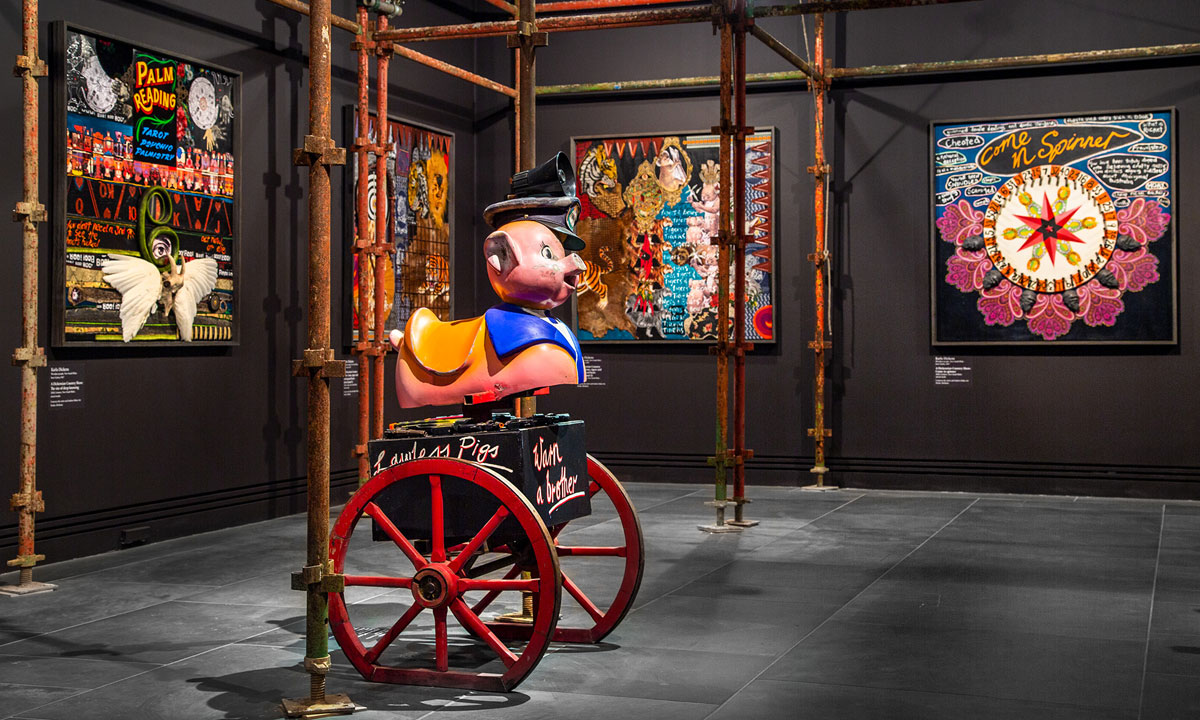‘In this immensely strange world, art is our lifeboat’
The role of art in society has never been clearer, writes Art Gallery of SA director Rhana Devenport, as the gallery releases a video teaser for a new virtual exhibition series on the 2020 Adelaide Biennial of Australian Art: Monster Theatres.


An installation view of the 2020 Adelaide Biennial featuring MORPH by Polly Borland. Photo: Saul Steed
Artists create portals to the imagination, to history, to the future, to emotions and to thought. Never in my lifetime has the role of art in society been distilled so clearly, as artists offer solace and criticality in equal measure.
What is the role of art as we collectively navigate these utterly uncharted waters?
Today a loved one quoted the Sumatran poet, actor and director Iswadi Pratama: “If you can make people feel, you can make them think.”
Moving back in time, the ancient Greeks understood music as the study of relationships between invisible, internal objects. And now as the world finds itself at a loss, it is artists we turn to in our imposed solitude – in the transporting music we listen to, the absorbing books we read, the performances or films we watch online, or the visual art that brings us quiet joy.
Art tells the universal truth of our time; it reminds us of our humanity in all its fragility and fortitude. Art is the work of the imagination; it offers a direct connection to empathy, pleasure, analysis and insight, and reveals ourselves to us. Art is essential.
Twenty years ago the Polish sociologist Zygmunt Bauman wrote a book called Liquid Modernity, a term he uses to describe our current world of endemic uncertainty, where “solid” modernity has fallen away. What is required in this world of liquid modernity is to be constantly ready and willing to change tactics at short notice, to abandon commitments and loyalties without regret and to pursue opportunities according to their current availability. In this immensely strange world we now find ourselves in, this “liquid modernity”, I firmly believe that art is our lifeboat.
One of the tremendous things about the Adelaide Biennial of Australian Art is the way it champions the creation of new projects by Australian artists at vastly different stages in their careers, making vital new connections with audiences. For 30 years the Biennial, presented by AGSA, has supported and connected the work of around 450 ambitious and fearless artists to around one million visitors.
ABOVE: A virtual walk-through of Monster Theatres, released as a teaser for a 2020 Adelaide Biennial virtual exhibition series.
The 2020 Adelaide Biennial, Monster Theatres, through its individual projects, has harnessed the evocative power implicit in the notions of both the monster – fright, horror, dread and strangeness – and the theatre – drama exaggeration, spectacle and tragedy – to conceptualise and deal with the great anxieties of our age.
As curator Leigh Robb so eloquently said:
“The term monster comes from the Latin monere, to warn, and monstrare, to show. The exhibition title hints at a double narrative which also resonates through the multiple meanings of ‘theatre’. Deriving from the Greek words theatron (a place to behold) or theaomai (to see), today the word may also imply a communal or dramatic space for spectacle and storytelling; an operating theatre for examination, dissection and potential healing; or a theatre of war, where nations and ideologies clash, sometimes violently, and all too frequently. Yet a theatre is also an arena – an active social space, a vulnerable and potent testing ground for new ideas, as well as new resonances between artists and audiences.”
Knowing what we now know, there are many works in Monster Theatres that have assumed new and prescient meanings. Abdul Abdullah’s Understudy, 2020, for example, has an almost clairvoyant air with its sole audience member before an illuminated yet empty stage.

Abdul Abdullah’s human-monkey hybrid Understudy in the 2020 Adelaide Biennial at the AGSA. Photo: Saul Steed
Given the needs of spatial distancing, Garry Stewart and Australian Dance Theatre’s new performance work for the Biennial, Colony, will not be seen in the flesh by the public for some time. Tough, visceral and experimental, this work makes a potent statement as one of the first major Australian works to respond, albeit intuitively, to the COVID-19 context.
Who would have imagined that in March 2020 there would be such a theatre of anxiety where the virus conjoins with the aftermath of bushfires.
Is this the moment for an exhibition that takes an unflinching stare into the eye of the beast?
Is this a time when the interrogations of Australian historical narratives – whether they be the underbelly of a Dickensian circus, the legacy of an aberrant coroner or the imagined song of an ancient land – are brought to bear?
Is this a time when our attention is honed by considering the frailty of bee life, the enchantment of myth and the importance of deep listening?
Is this a time when the poeticism of artists brings lyrical moments and transcendent encounters, making us look again, think again, and open ourselves up to the new and now? Yes and absolutely.
We have channelled our energies from the spatial to the virtual
Some 50,000 people experienced Monster Theatres in the month before we closed our doors at AGSA on March 25. The exhibition has been described as timely and honest; highlighting the role of artists as “social barometers”.
As Robb explains: “Monster Theatres proposes an arena of speculation, a circus of the unorthodox and the absurd, a shadow play between truth and fiction.”
Participating senior artist Mike Parr shared this with us today: “…what an extraordinarily strong exhibition Monster Theatres is … so many works that exhibit a ferocious, corrosive necessity across a great range of urgent responses.”

A Dickensian Country Show, by Karla Dickens, 2020 Adelaide Biennial of Australian Art. Photo: Saul Steed
Artists are at the heart of AGSA’s work; their work informs everything we do. Right now the AGSA team is working hard to ignite new avenues for us to directly support artists, while devising and launching new digital environments that link art and people.
We have channelled our energies from the spatial to the virtual. We have created virtual tours of Monster Theatres, with artist interviews, commentaries and video walkthroughs. Also Stelarc’s 9m robot, Reclining Stickman, 2020, is now being live-streamed and can be operated online, from anywhere in the world.
There is much more work to be done in this arena of action as we craft new digital platforms for art. AGSA is part of a radical revisioning of how public cultural entities operate. The urgency of our work has never been more real.
Rhana Devenport is Director of the Art Gallery of South Australia.
The AGSA is in the process of creating a virtual exhibition series based around the 2020 Adelaide Biennial: Monster Theatres, which will include video walkthroughs of installations and artist interviews. Also available are podcasts featuring Biennial artists and Monster Theatres-focused at-home family activities.




